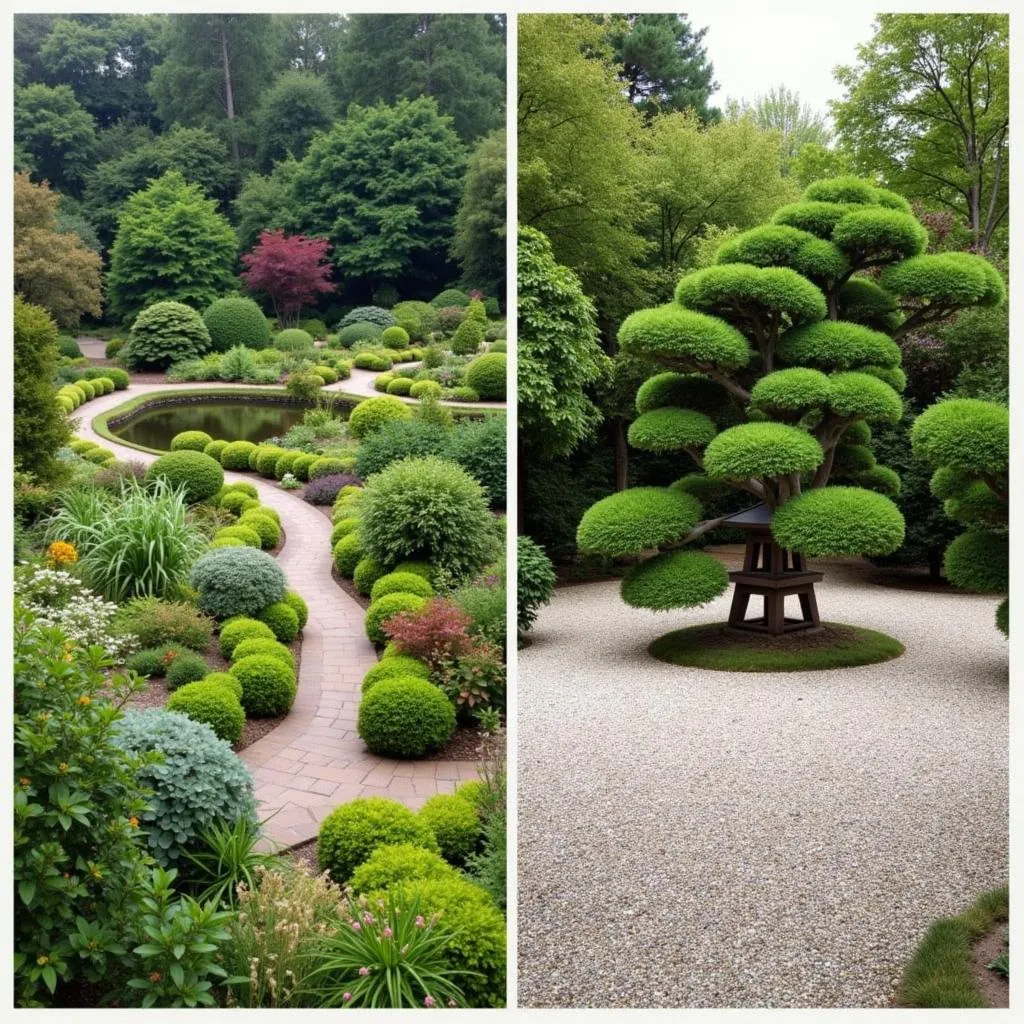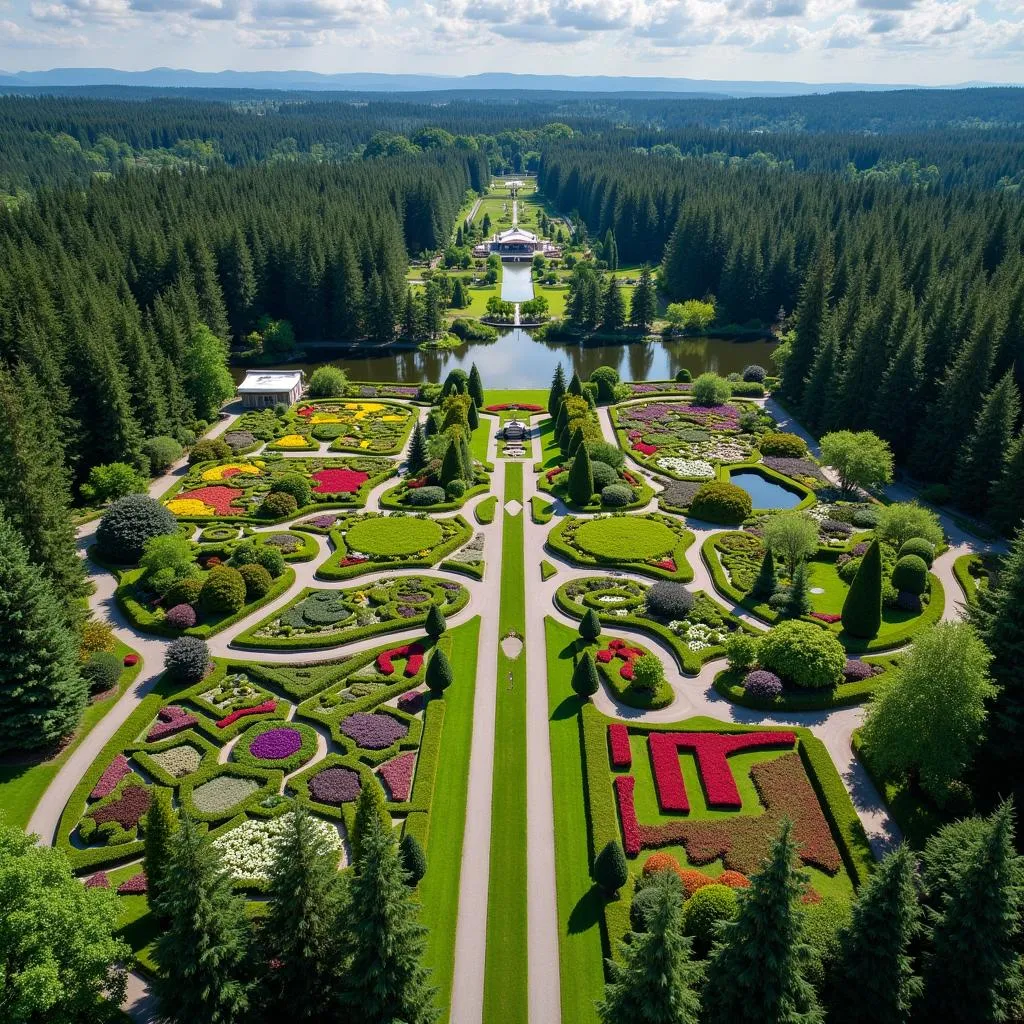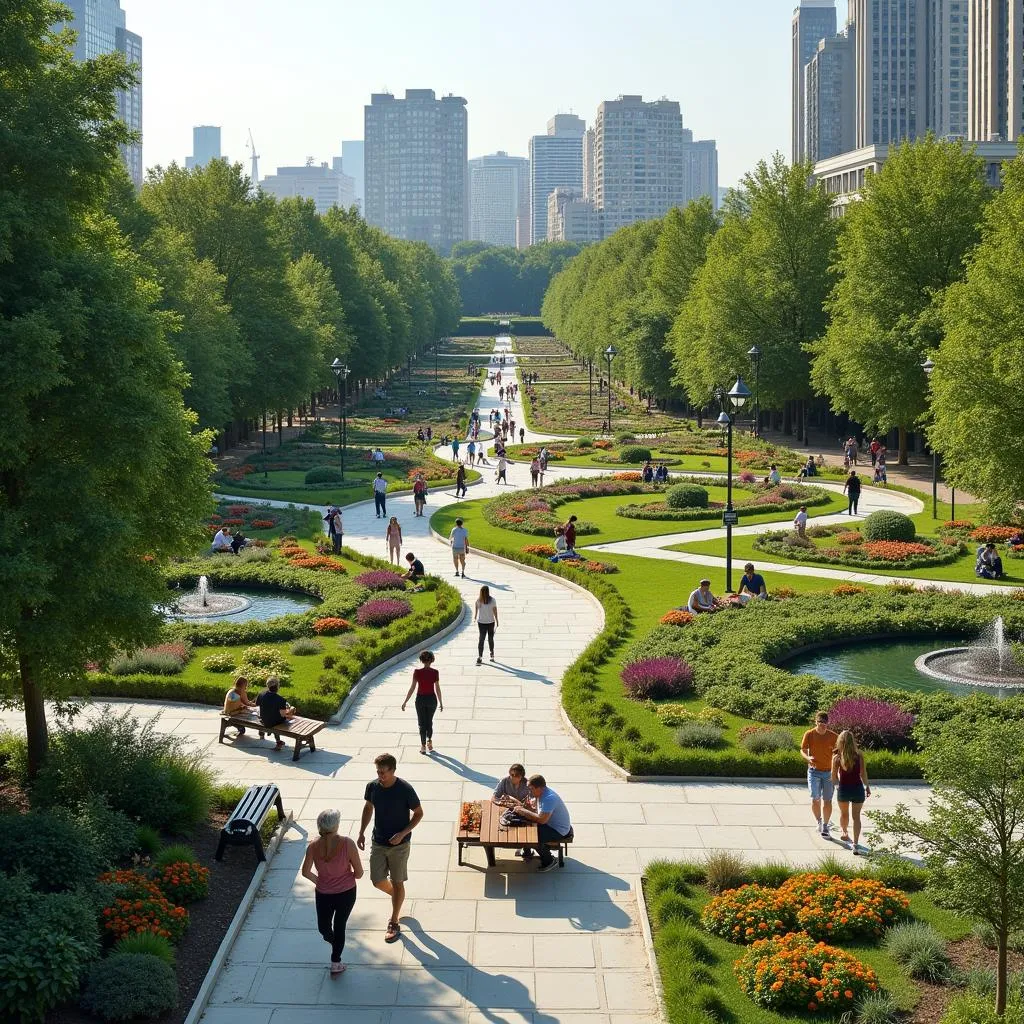The topic “describe a garden you have visited and liked” is a common theme in IELTS Speaking tests, particularly in Part 2. This topic has appeared frequently in past exams and is likely to continue being a popular choice for examiners. It allows candidates to showcase their descriptive language skills, vocabulary related to nature and personal experiences, and ability to structure a coherent response.
Part 1: Introduction and Interview
In Part 1, the examiner may ask some general questions about gardens and nature. Here are some possible questions and sample answers:
- Do you like visiting gardens?
Band 6-7 Answer: Yes, I do enjoy visiting gardens. They’re peaceful places where I can relax and appreciate nature. I try to visit local gardens when I have free time.
Band 8-9 Answer: Absolutely, I’m quite passionate about visiting gardens. They offer a serene escape from the hustle and bustle of daily life. I find them not only visually appealing but also therapeutically beneficial. Whenever I travel to a new city, I make it a point to explore its botanical gardens or notable green spaces.
- Are there any famous gardens in your country?
Band 6-7 Answer: Yes, there are a few well-known gardens in my country. One of the most famous is the Royal Botanic Gardens, which attracts many tourists each year. It’s known for its diverse plant collection.
Band 8-9 Answer: Indeed, my country boasts several renowned gardens. The Royal Botanic Gardens stands out as a prime example, drawing countless visitors annually. It’s particularly celebrated for its extensive collection of rare and indigenous plant species. Another noteworthy mention is the Japanese Garden, which exemplifies the art of landscape design and cultural exchange.
 Famous gardens in a country including botanical and Japanese gardens
Famous gardens in a country including botanical and Japanese gardens
Part 2: Long Turn
Cue Card:
Describe a garden you have visited and liked
You should say:
- Where it was
- When you visited it
- What you saw there
- And explain why you liked it
Band 6-7 Sample Answer:
I’d like to talk about a garden I visited last summer. It was the Butchart Gardens in Victoria, Canada. I went there with my family during our vacation.
The garden was really beautiful and big. There were different sections, like the Rose Garden and the Japanese Garden. I remember seeing lots of colorful flowers and plants. There were also some nice fountains and statues.
What I liked most about the garden was how peaceful it was. Even though there were many visitors, it didn’t feel crowded. The flowers were arranged in interesting patterns, which made it look very artistic. I also enjoyed the smell of the roses and other flowers.
We spent a few hours walking around and taking photos. It was a nice break from the busy city, and I felt relaxed there. That’s why I liked this garden so much.
Band 8-9 Sample Answer:
I’d like to regale you with my experience of visiting the world-renowned Butchart Gardens in Victoria, Canada. This horticultural marvel was the highlight of my family vacation last summer, and it left an indelible impression on me.
The gardens are a testament to human creativity and nature’s beauty working in harmony. They’re divided into several themed areas, each with its own distinct character. The Rose Garden was a symphony of colors and fragrances, while the Japanese Garden offered a serene, meticulously manicured landscape that seemed to transport visitors to another world.
What struck me most about Butchart Gardens was its impeccable design and maintenance. The floral displays were arranged with artistic precision, creating stunning visual patterns that seemed to change with every step. Interspersed among the flora were elegant fountains and statues, adding an element of classical beauty to the natural splendor.
The reason I hold this garden in such high regard is multifaceted. Firstly, it provided a welcome respite from the frenetic pace of urban life, offering a space for quiet contemplation and connection with nature. Secondly, the sheer diversity of plant species was intellectually stimulating, piquing my curiosity about botany and horticulture. Lastly, the garden’s history – being transformed from an exhausted limestone quarry – is a powerful reminder of nature’s resilience and the potential for beauty to emerge from the most unlikely places.
In essence, Butchart Gardens epitomizes the perfect blend of natural beauty and human artistry, making it a truly unforgettable experience.
 Aerial view of Butchart Gardens in Victoria, Canada
Aerial view of Butchart Gardens in Victoria, Canada
Follow-up Questions:
- How do you think gardens in cities benefit local communities?
Band 6-7 Answer: I think city gardens are very important for communities. They give people a place to relax and enjoy nature. Gardens can also help reduce pollution and make the city look nicer. They’re good for people’s health too, as they provide a place for exercise and fresh air.
Band 8-9 Answer: Urban gardens play a pivotal role in enhancing the quality of life for local communities. They serve as green oases in the concrete jungle, offering residents a much-needed respite from the stresses of city life. These spaces contribute significantly to improving air quality by acting as natural air purifiers, thereby mitigating the effects of urban pollution. Moreover, community gardens foster social cohesion by providing shared spaces where people can interact, collaborate, and build relationships. From a health perspective, these green spaces encourage physical activity and have been shown to have positive effects on mental well-being, reducing stress and anxiety levels. Additionally, urban gardens can serve educational purposes, teaching children about nature, ecology, and sustainable living practices.
- Do you think it’s important to teach children how to grow plants?
Band 6-7 Answer: Yes, I think it’s very important to teach children about growing plants. It helps them understand nature better and learn about where food comes from. Growing plants can also teach kids responsibility as they need to take care of the plants regularly. It’s a fun and educational activity for children.
Band 8-9 Answer: Absolutely, I believe teaching children how to grow plants is crucial for their holistic development. This hands-on experience instills a deep appreciation for nature and helps children understand the intricate relationships within ecosystems. It’s an excellent way to impart practical knowledge about biology, chemistry, and environmental science in a tangible, engaging manner. Moreover, the process of nurturing a plant from seed to maturity fosters patience, responsibility, and a sense of achievement in children. This skill also promotes sustainability awareness, encouraging children to think about their environmental impact and the importance of preserving natural resources. In our increasingly digital world, gardening provides a much-needed connection to the physical environment, promoting both physical activity and mental well-being.
 Children learning gardening skills
Children learning gardening skills
Part 3: Two-way Discussion
- How have gardens changed over the years in your country?
Band 6-7 Answer: Gardens in my country have changed quite a bit over the years. In the past, they were mostly just for growing vegetables or flowers. Now, many gardens are designed for relaxation and looking nice. People use more modern materials and designs. Also, there’s more focus on having gardens that don’t need much water because of environmental concerns.
Band 8-9 Answer: The evolution of gardens in my country has been quite remarkable. Traditionally, gardens were primarily utilitarian spaces for growing produce or medicinal herbs. However, there’s been a significant shift towards aesthetic and recreational purposes. Modern gardens often incorporate sophisticated design elements, blending hardscaping with carefully curated plant selections. There’s also been a growing emphasis on sustainability, with many gardeners opting for native species that require less water and maintenance. Another notable trend is the rise of vertical and rooftop gardens in urban areas, maximizing limited space. Additionally, there’s an increasing integration of technology, such as automated irrigation systems and apps for plant care, reflecting our digital age.
- Do you think the government should invest more in creating public gardens?
Band 6-7 Answer: Yes, I think the government should invest more in public gardens. They’re good for the environment and people’s health. Public gardens give everyone a chance to enjoy nature, even in cities. They can also be tourist attractions, which might help the local economy. More gardens could make cities more beautiful and pleasant to live in.
Band 8-9 Answer: I firmly believe that increased government investment in public gardens would yield substantial benefits for society. Public gardens serve as vital green infrastructure, contributing to urban biodiversity and helping to mitigate the effects of climate change. They act as ‘green lungs’ for cities, improving air quality and reducing the urban heat island effect. From a social perspective, these spaces promote community cohesion and provide equal access to nature, regardless of socioeconomic status. They also offer significant health benefits, both physical and mental, by encouraging outdoor activities and providing stress-relieving environments. Moreover, well-designed public gardens can become iconic landmarks, enhancing a city’s appeal to tourists and potentially boosting the local economy. By prioritizing the development of public gardens, governments can make a long-term investment in public health, environmental sustainability, and urban livability.
 Public garden showcasing government investment
Public garden showcasing government investment
Key Vocabulary and Phrases for High Scores
-
Horticultural marvel /hɔːrtɪˈkʌltʃərəl ˈmɑːrvəl/ (noun phrase): An impressive or extraordinary garden or plant display.
Example: The Kew Gardens in London is widely regarded as a horticultural marvel. -
Botanical diversity /bəˈtænɪkəl daɪˈvɜːrsəti/ (noun phrase): The variety of plant species in a particular area.
Example: The botanical diversity of the Amazon rainforest is unparalleled. -
Meticulously manicured /məˈtɪkjələsli ˈmænɪkjʊərd/ (adjective phrase): Carefully and precisely trimmed and maintained.
Example: The palace grounds featured meticulously manicured hedges and lawns. -
Sustainable landscaping /səˈsteɪnəbəl ˈlændskeɪpɪŋ/ (noun phrase): Garden design and maintenance practices that conserve water and other resources.
Example: Many modern gardens incorporate principles of sustainable landscaping to reduce their environmental impact. -
Aesthetically pleasing /esˈθetɪkli ˈpliːzɪŋ/ (adjective phrase): Visually attractive or beautiful.
Example: The garden’s layout was aesthetically pleasing, with a harmonious blend of colors and textures.
Examiner’s Advice
To achieve a high score in the IELTS Speaking test when describing a garden:
-
Use a wide range of vocabulary related to nature, plants, and landscape design. Include specific plant names if possible.
-
Employ varied sentence structures and complex grammar to demonstrate language proficiency.
-
Provide detailed descriptions using sensory language to bring your experience to life.
-
Connect your description to broader themes such as environmental conservation, urban planning, or cultural significance.
-
Practice speaking about different types of gardens and related topics to improve fluency and confidence.
Remember, the key to success is not just knowing what to say, but how to say it effectively and fluently. Regular practice and expanding your vocabulary will help you achieve your desired score.
Describe a park you would like to visit again to further enhance your speaking skills on similar topics. Additionally, learning to describe a natural place such as parks or mountains can broaden your ability to discuss various outdoor environments in the IELTS Speaking test.


